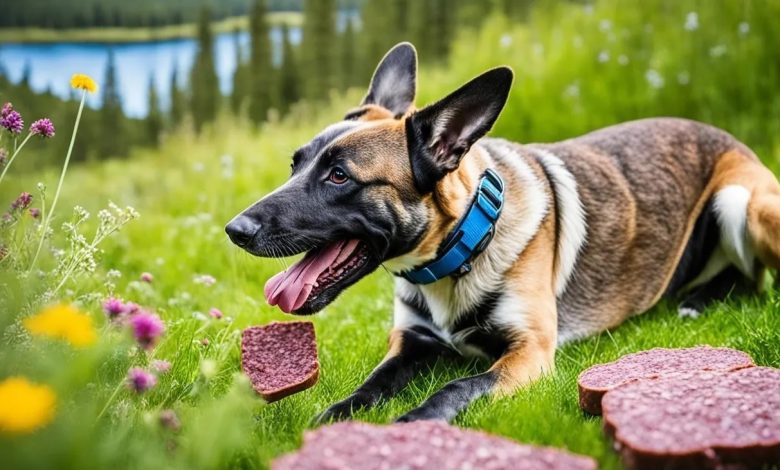Why are kangaroo meat and kangaroo dog treats the go-to in novel proteins?

If you have read this far, you might want clarification on what a Novel Protein means? And why you and your dog might want it.
Novel Proteins are proteins that are rarer than those found in our common commercial dog foods. This means that they will be new to your pet (ie they have never eaten before).
The most common MEATS that are included in your dog food and dog treats will include proteins that make up the majority of pet diets such as chicken beef and lamb.
The reason that these are common is that they are part of the bulk human food chain, and so are mass farmed. Scales of economy make the offcuts also cheap as the main meat ingredient in dog food and dog treats.
While this is not all true for every dog food, it does mean that the following meats and their proteins are likely to be more rare (or novel) – such as crocodile, wild duck and kangaroo. They might also include salmon and general fish products, but maybe not, if that is what you regularly feed your dog.
WHY might a novel protein be important to your dog?
This goes exactly against the advice of most commercial dog food companies, but advice about keeping your dog on the same kibble for a year minimum, is precisely the kind of thing that can bring an allergy on, so it seems. That is, when a dog is fed the same meat or vegetable/ grain for long periods, they can gain sensitivities to it, and even full-blown allergies.
Mixing your meats up (the ideal use of different single ingredient meat dog treats) as a supplement can help reduce the likely hood of the creation of an allergy.
But not just any novel or more rare meat is as good as others. For instance, if your dog hasn’t had a lot of lamb or pork, then this would be novel to them. But these meats are often quite fatty, and even if the fat is rendered away, the fat type is often saturated.
Not completely bad for a dog, but some dogs with tricky stomachs can have bad reactions to a lot of saturated fat, or loose stools or even form pre-pancreatitis reactions.
On the plus side for kangaroo meat, it is considered highly hypo-allergenic. That is, it carries a very low risk of an allergic reaction when introduced to a dog.
Roo meat is increasingly used in dog foods and dog treats due to its nutritional benefits and low environmental impact. We will explore the other nutrition facts about it shortly, but something good to know is the low environmental impact value.
At the moment shark meat and shark cartilage is banned in parts of America, because of careless fishing of all shark species (endangered species are caught along with those in plentiful supply). But since Kangaroo is mostly caught wild in Australia, and is caught under a quota system that is only one third fulfilled each year, because in parts of the country they are seen as a pest) – then kangaroo meat is currently one of the most sustainable and ecologically sensible meats to feed humans and their dogs.
What else does kangaroo treats have besides novel proteins?
High absolute protein, with unique amino acid mix, and highly bio- available. With commercial dog food usually having around 30% crude protein (and over half of the total product being plant based) your dog can really do with more protein in its life.
Protein is the building block for their body. But something that meat excels at (ie high bio availability means high utilising by your dog’s body rather than being wasted (expelled as waste).
A lean meat, isn’t just about the total fat content (which is low) – but it also means high in Omega 3. This is something that we mostly associated with fish like Salmon. The value of Omega 3 is its work with the dogs brain and heart and numerous other functions, but also it’s a prime Anit inflammatory. Ideal for dogs who suffer from any neve issues or arthritis.
Another value in roo omega 3, is that it naturally creates a healthy coat and skin. If your dog has environmental allergies like to a particular grass at the dog park, Omega 3 can massively reduce the issue, conditioning the skin pores, between their pads and toes so that their feet don’t feel as itchy and reduces their urge to lick their feet.
Also be aware that while many sites tell you that sunflower oil, or coconut oil etc are the best for shiny coats, that is often their limitation. They add calories to their food intake without the anti-inflammatory properties or heart and brain benefits of Omega 3. You do not want empty calories going into your dog, at the sacrifice of meat protein or Omega 3.
Nutrient rich. Proteins are a given. But Low fat, and no carbs also make it an ideal food source. But there is such more, such as the micro nutrients of vitamins and minerals are also useful. Most notable in roo meat is iron, zinc, and B vitamins.
Roo meat novel protein and much more
While hypoallergenic and lean proteins are great, the single ingredient roo meat (as found mostly in Kangaroo dog treats like roo jerky, roo tendons or roo cartilage), if there is an allergic reaction because of an ingredient in their regular kibble, many vets will use kangaroo and wholemeal rice for six weeks as an exclusion diet to confirm that it is a food ingredient there were previously eating that caused the allergy symptoms.
Coincidently while natural treats are the original teeth cleaners, are naturally the perfect dental chew, most of the kangaroo dog treats are great for cleaning teeth. They have the right rigidity and surface hardness to scrape tartar from teeth.
But being novel and good for a dog is not much use, unless they like the smell and taste of a dog treat. Fortunately, not only is kangaroo meat highly digestible (high bio availability), but it also is highly palatable.
To make dogs want to eat kibble (that is usually full of plants that they would not naturally eat) – dog food scientists stack kibble with extra sugar, salt and fats.
These three things are exactly the ‘nutrients’ that raw feeders go out of their way to avoid feeding their dogs.
If your dog has a sensitive stomach (poor bacterial biome) and is susceptible to liquid stools, they might be reticent to eat natural food, however being highly digestible and tasty makes roo great for stimulating appetite and getting hard to please eaters, eating again.
CONCLUSION
Novel is often considered new and unique. While kangaroos have obviously evolved a long time ago, its what the protein in their meat represents to solving many common dog problems, that makes it VITAL and unique food.
The actual miracle with this food is that it is abundant in Australia, and is garnered under quota to help the environment because they have over populated it. It not only solves an environmental issue, but provides a unique benefit to dogs. The intersection of being very healthy as well as one of the best tasting meats.
You might struggle to find a lot of dog food with a substantial amount of roo in it, because the harvesting and drying of roo is a lot more technical than for many farm animals, but buying it via oven dried dog treats, in full concentration levels, can go a long way to fixing dog issues you need solved for your dog.




